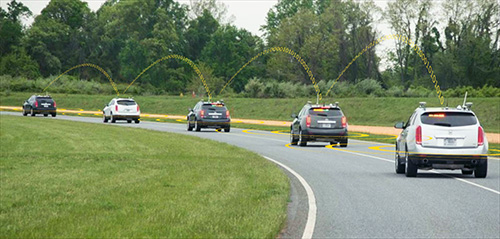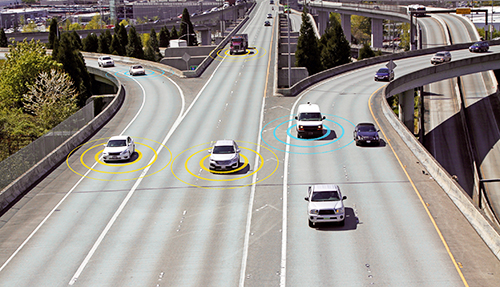How an Automated Car Platoon Works

With emerging automated driving technology, self-driving cars may soon have the capability to talk to each other and form a platoon on a highway.
The vehicle at the very front of the platoon controls the speed. The following vehicles then snap together in a single-file line behind the first vehicle and drive themselves safely at close proximity on the highway.
But, how does it work? And why do we want self-driving cars to form platoons?

In essence, platoon formations improve travel time, increase lane capacity, and reduce congestion—which means we spend less time sitting in traffic, less money adding new lanes, and less money buying fuel.
Automated driving systems (ADS), also referred to as self-driving cars, are likely the future of transportation. Instead of driving as individual units on highways, automated driving systems can connect and exchange information with one another and form a smooth train. The result is increased capacity on the road that gets us to destinations faster and more efficiently.
In a recent study, a car platooning proof-of-concept consisting of five Cadillacs with automated longitudinal control was tested and evaluated at Aberdeen Proving Ground, a U.S. Army test facility in Maryland.
The study was conducted by the Federal Highway Administration’s (FHWA) Turner-Fairbank Highway Research Center (TFHRC), the U.S. Department of Transportation’s Volpe National Transportation Systems Center, and the U.S. Army Aberdeen Test Center.
“I think what makes this research cutting-edge is that we are focusing on the cooperative side of automated driving systems,“ said Dr. Taylor Lochrane, Cooperative Automation Research Program technical manager at TFHRC. “If vehicles can communicate with each other and the infrastructure, we can use that capability and coordinate traffic more efficiently and save our economy billions in wasted time and fuel.”
How it Works
For automated driving systems to form a platoon, they need a special computer onboard, which is what the cars in the study were equipped with. Connected to that computer is a vehicle-to-vehicle (V2V) communications device. This device receives and transmits data from one car to another using Dedicated Short-Range Communications.
V2V technology allows cars to share information with each other at a really fast pace.
“By adding connectivity between cars, we can manage traffic with clusters of vehicles instead of individual vehicles,” said Dr. Wassim Najm, Advanced Vehicle Technology chief at the Volpe Center. “With better traffic management, we can improve mobility.”
At the test site, the cars were able to talk to each other and share information, such as whether they needed to speed up or slow down to follow the lead vehicle at a desired following distance.
Najm’s team piloted the technical and analytical work for testing and evaluating the car platooning proof-of-concept.
“We built the test procedures for the track to test the vehicles using vehicle-to-vehicle communications,” said Najm. “We now have a better understanding of the performance parameters and the test procedures needed for advancing the car platooning technology.”
Lochrane’s team programmed the computers with platooning algorithms developed by FHWA and their partners in earlier projects.
The computers inside the vehicles not only control braking and acceleration, but they also take in radar data of the front vehicle that is part of the production adaptive cruise control system to create a Cooperative Adaptive Cruise Control capability. The cars can see where the car in front of them is located and how fast it is going, then control the braking and throttle, and therefore control the position of the following vehicles.
“The followers follow the vehicle in front and listen to all the other vehicles in the stream and that’s how they all communicate—the computers are able to compute the current and predicted trajectory of the vehicle to maintain their position,” said Lochrane.
What’s Next?
The purpose of the initial research was to develop test procedures and evaluate a car platooning proof-of-concept. The team found some weaknesses and anomalies with the proof-of-concept technology that will help researchers design and build car platooning prototypes for future testing.
Looking ahead, TFHRC and the Volpe Center will continue studying cooperative automated driving systems. The team is working on making its data and research available to anyone interested in the technology.
“We are developing an open source automated vehicle platform using a robot operating system (ROS) architecture for leaders in industry and academic researchers to collaborate on advancing cooperative automated driving technology,” said Lochrane.
The team hopes to eventually partner with industry to have car platooning prototypes that can also automate steering to enable lane changing and merging onto a highway.
Read the full report: Test and Evaluation of Vehicle Platooning Proof-of-Concept Based on Cooperative Adaptive Cruise Control
The testing and evaluation of car platooning technology was a collaboration between the Federal Highway Administration’s Turner-Fairbank Highway Research Center, U.S. DOT’s Volpe National Transportation Systems Center, and the U.S. Army. (FHWA photo)
For More Information
video that explains platooning.
